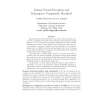Free Online Productivity Tools
i2Speak
i2Symbol
i2OCR
iTex2Img
iWeb2Print
iWeb2Shot
i2Type
iPdf2Split
iPdf2Merge
i2Bopomofo
i2Arabic
i2Style
i2Image
i2PDF
iLatex2Rtf
Sci2ools
EATCS
1998
1998
Human Visual Perception and Kolmogorov Complexity: Revisited
Experiments have shown [2] that we can only memorize images up to a certain complexity level, after which, instead of memorizing the image itself, we, sort of, memorize a probability distribution in terms of which this image is “random” (in the intuitive sense of this word), and next time, we reproduce a “random” sample from this distribution. This random sample may be different from the original image, but since it belongs to the same distribution, it, hopefully, correctly reproduces the statistical characteristics of the original image. The reason why a complex image cannot be accurately memorized is, probably, that our memory is limited. If storing the image itself exhausts this memory, we store its probability distribution instead. With this limitation in mind, we conclude that we cannot store arbitrary probability distributions either, only sufficient simple ones. In this paper, we show that an arbitrary image is indeed either itself simple, or it can be generated by a s...
| Added | 22 Dec 2010 |
| Updated | 22 Dec 2010 |
| Type | Journal |
| Year | 1998 |
| Where | EATCS |
| Authors | Vladik Kreinovich, Luc Longpré |
Comments (0)

